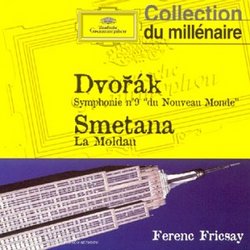One of the most unique New World recordings ever
Larry VanDeSande | Mason, Michigan United States | 07/22/2008
(5 out of 5 stars)
"Here is a repackaged version of Ferenc Fricsay's Dvoark "New World" Symphony No. 9, Smetana Moldau, and Liszt Les Preludes, recorded in 1959-60 with the Berlin Philharmonic. These recordings have been in publication almost consistently since they first arrived on DG LP way back when, and for good reason -- this is one of Fricsay's most cherished recordings.
For those that have never been exposed, the Hungarian Friscay (pronounce free-SHOY) came out of the postwar boomlet of conductors, what we know today as the golden age of orchestral conductors in Europe. This was the time of Furtwangler, Karajan, Bohm, Solti, Bernstein, Szell and many other of the biggest name conductors in history. Friscay built his reputation through a highly romanticized approach that features a lot of rubato -- most of which would be considered inappropriate in today's period performance influenced epoch -- and orchestral modulations that made any band sound much bigger than they are. He had a working relationship wtih a new orchestra of the time -- the RIAS, or Radio in the Amercian Sector orchetra.
I first came to know the Fricsay style through his LP of Beethoven's Symphony 7 with BPO on the DG label. Here was highly measured and controlled Beethoven most of the way through with little of the dance rhythm some conductors find in the score. At the very end, Fricsay let it rip and things changed dramatically, builidng a fire-breathing and hair-raising conclusion that renedered the whole thing unforgettable.
You hear these tactics most effectively here in the finale of the New World symphony where the conductor waits a tad longer than most to implement the horn blasts after the opening string sequence. Put most directly, Fricsay is simply more exciting in this music than other conductors and he got the 1959 Berlin Philharmonic to play it his way, including a wailing woodwing during the transition between opening and second ideas in the finale. In my opinion, the Berlin Philharmonic has never sounded better for any conductor than they sound for Fricsay in this recording. It is alive and human, 180 degrees from the ultrasmooth Mercedes on the Autobahn approach of Karajan.
The new issue in DG's "Collection du millenaire" packaging comes in a slimline hard plastic container and only contains a page of notes in French. I assume Amazon imported this because the original DG issue -- the one with Fricsay's bald head on the cover -- is now only available via an expensive Australian import. As you probably noted when you checked this out, this one is quite a bit less expensive. It's definitely worth it since the remastering seems to be a bit improved. Even if not, you get one of Ferenc Fricsay's best-ever recordings and one of the most original New World symphonies in existence."


 Track Listings (6) - Disc #1
Track Listings (6) - Disc #1